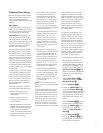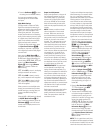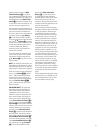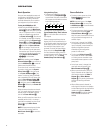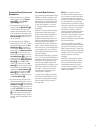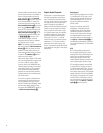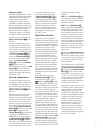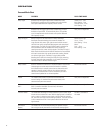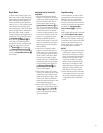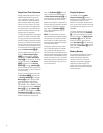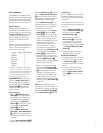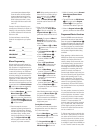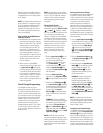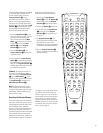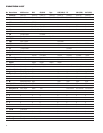
29
Night Mode
A special feature of Dolby Digital is the
Night mode, which enables Dolby Digital
input sources to be played back with full
digital intelligibility while reducing the
maximum peak level and lifting the low
levels by
1/4 to 1/3. This prevents abruptly
loud transitions from disturbing others
without reducing the impact of the digital
source. The Night mode is available only
when Dolby Digital mode is selected.
The Night mode may be engaged when a
Dolby Digital DVD is playing by pressing
the
Night Button
K
on the remote.
Next, press the
⁄
/
¤
Buttons
C
to
select either the middle range or full-
compression versions of the Night mode.
To turn the Night mode off, press the
⁄
/
¤
Buttons
C
until the message
in the
Main Information Display
K
reads D-R OFF. When the Night mode
is active, the
Night Mode Indicator
L
will also light.
IMPORTANT NOTES ON DIGITAL
PLAYBACK:
1. When the digital playback source is
stopped, or in a pause, fast forward or
chapter search mode, the digital audio
data will momentarily stop, and the
channel position letters inside the
Speaker/Channel Indicators
N
will
flash. This is normal and does not indi-
cate a problem with either the AVR480
or the source machine. The AVR480
will return to digital playback as soon
as the data is available and when the
machine is in a standard play mode.
2. Although the AVR480 will decode
virtually all DVD movies, CDs and HDTV
sources, it is possible that some future
digital sources may not be compatible
with the AVR480.
3. Note that not all digitally encoded
programs and not all audio tracks on
a DVD contain full 5.1-channel audio.
Consult the program guide that accom-
panies the DVD or laser disc to deter-
mine which type of audio has been
recorded on the disc. The AVR480 will
automatically sense the type of digital
surround encoding used, indicate it in
the
Bitstream Indicators
A
and
Channel Input Indicators
N
and
adjust to accommodate it.
4. When a Dolby Digital or DTS source
is playing, you normally may not be able
to select some of the analog surround
modes such as Dolby Pro Logic II, Dolby
3 Stereo, Hall, Theater or 5CH Stereo,
except with special audio
tracks or data
format selected (see page 27).
5. When a Dolby Digital or DTS source
is playing, it is not possible to make an
analog recording using the
Tape
5
or Video 1
B
record outputs, if the
source is only connected to a digital
input of the AVR480.
Tape Recording
In normal operation, the audio or video
source selected for listening through the
AVR480 is sent to the record outputs.
This means that any program you are
watching or listening to may be recorded
simply by placing machines connected to
the outputs for
Tape Outputs
5
or
Video 1 Outputs
AB
in the record
mode.
When a digital audio recorder is connected
to the Coaxial Digital Audio Output
0
, you are able to record the digital sig-
nal using a CD-R, MiniDisc or other digi-
tal recording system. Note that all digital
signals will be passed through to the
coaxial digital output, no matter which
kind of digital input was selected.
NOTES:
• The digital outputs are active only when
a digital signal is present, and they do
not convert an analog input to a digital
signal, or change the format of the digi-
tal signal (e.g., Dolby Digital to PCM
or vice versa. In addition, the digital
recorder must be compatible with the
output signal. For example, the PCM
digital output from a CD player may be
recorded on a CD-R or MiniDisc, but
Dolby Digital or DTS signals may not.
• Please make certain that you are aware
of any copyright restrictions on any mate-
rial
you copy. Unauthorized duplication
of copyrighted materials is prohibited
by law.



